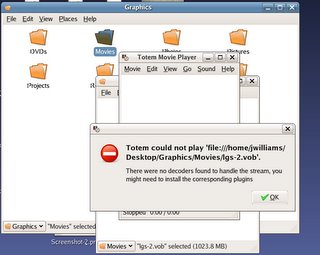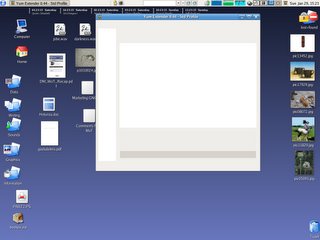I am running out of things that suck about GNOME. That's cool! By that I mean that all the other things I would have to say really belong in bugzilla, not here :-)
But today's gripe is this: the bug reporting, triaging and fixing system appears to be fundamentally broken.
I will base my commentary of these premises:
1. All software has bugs
2. Users hate bugs
3. Users find it very difficult to produce useful (to developers) bug reports
4. Bugs cause lost productivity for both users and developers (who have to fix them)
5. Bug fixing is often very difficult
6. The sheer number of bugs is a severe psychological barrier to fixing them
Immediate conclusions that follow are:
1. Minimizing the number of bugs leads to greater productivity and happiness for both users and developers, and hence should be a major goal of GNOME.
2. In order to achieve that goal, the quality of bug reports must be increased
3. Because users have limited ability (regardless of motivation) to increase the quality of bug reports, the more the bug reporting system can be automated, the better things will be for both users and developers.
So, what is the way forward? I can think of three broad areas:
1. Forget trying to make bugzilla more friendly to non-technical users. It could probably be done, but other, easier paths will lead to the same destinations. (By the way, the recent improvements are totally awesome!)
2. Delete all bugs from bugzilla and start again. (Tell everyone that we're doing this, and why.) Devote massive resources to the triaging system. Make sure that every bug that gets assigned to a developer is assigned to the corrects developer, has sufficient information to be useful, and is not a duplicate.
3. Bug Buddy needs love. Lots and lots of love. And when it has been loved so much that it is limp, it should be loved some more. Bug Buddy is not usable for non-technical users. Not convinced? Let me show you what I mean. (At last, some bling!)
Testing the latest Evolution from CVS:

Hmm... trouble! Better report it. Press the "Inform Developers" button. First Bug Buddy tells me that my information is out of date. Well, it told me that last night too, and I updated it then, but I suppose things may have changed. OK, download updates and wait while "Bug Buddy gathers information". Inspect the stack trace and confirm that it appears to be, indeed, about evolution-exchange-storage. But wait, what's this? Bug buddy tries to help me by eliminating duplicate bug reports. Cool! But what's all this about products that have nothing to do with evolution-exchange-storage? How is that relevant? Wouldn't it be better to present information about the application that crashed?
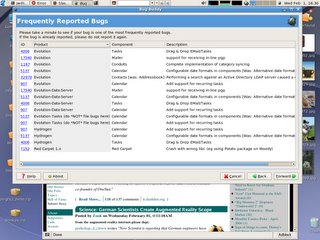
Whatever. Let's go to the next step. What's this? I have to choose the application that I'm reporting on? Doesn't Bug Buddy know already? It's got the stack trace. And couldn't the system that launched Bug Buddy tell what has crashed? Never mind. Let's try to pick the application. But wait, it's not there!
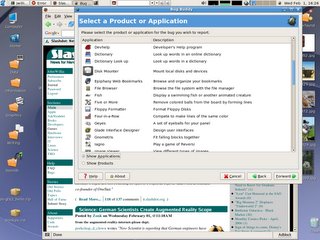
Oh, maybe evolution-exchange-storage is not an application. But hang on, Evolution is, why isn't it there? Oh well, try "Products" instead. (Puzzling over the difference between an "Application" and a "Product".) What now? Why are there so many duplicate entries, and how can I tell which one I should choose? And where is evolution-exchange-storage?

Hmmm. Oh, wait. I've been using GNOME for years, and I recall that once upon a time it was called "Ximian Connector". Look under "X", no, ... OK, there is a "Connector" (or two), one of them is (probably) the right one. Hang on, why is "Crossover" in this list? I have never installed that, ever, on any of my computers! Whatever ...
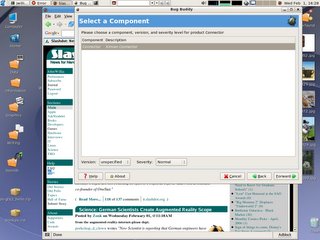
What's next? I have to tell Bug Buddy what version of the product I am reporting on? Can't the system that launched Bug Buddy provide that information? And what about "Severity"? How do I decide what to put in there?
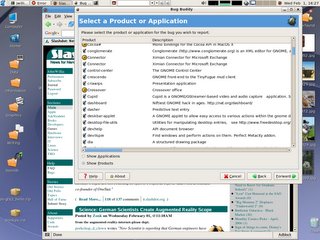
Whew! Finally I get to actually type in the bug report. It appears there should be exactly three steps to reproduce a bug. OK, I suppose I can adapt my experience to that framework. Now, once the information is entered, I get to choose what to do with the report. I have to choose between saving it as a text file, or emailing it. (Why can't I do both? What if mailing fails? Do I have to go through all this again?)
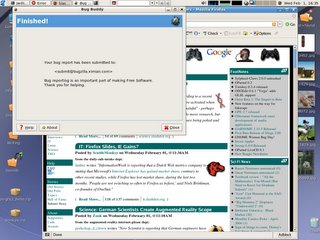
Yay! At last! The bug report has been filed. I feel a warm glow of satisfaction at having fulfilled my duty as a non-developer member of the GNOME community: I have filed a (damn good!) bug report. But wait, have I really? If I check bugzilla.gnome.org it does not appear to be there. Even days later. What's going on? Perhaps the mail did not get through? How do I check? What was that about sendmail in the mailing options?
Discover mailq, and the fact that the bug report was not, as claimed, file. Dismayed to find that now I have to learn how to configure sendmail. It's about enough to make a poor user want to cry...







